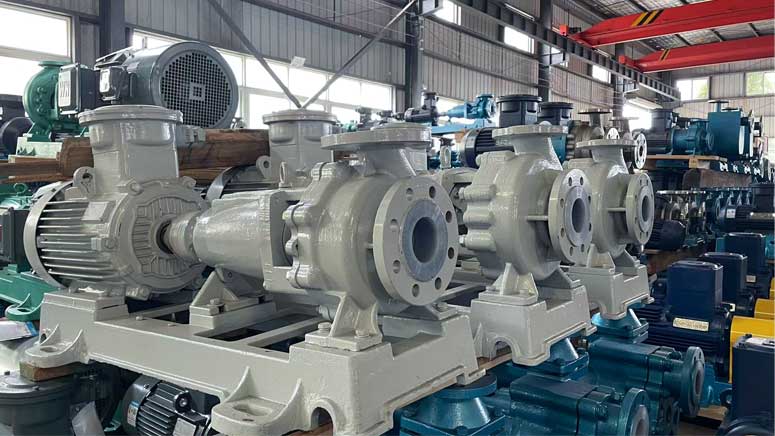PTFE (Polytetrafluoroethylene) centrifugal pumps are widely recognized for their excellent chemical resistance and durability, making them indispensable in industries such as chemical processing, pharmaceuticals, and environmental protection. One of the critical components of these pumps is the mechanical seal, which prevents leakage of the pumped fluid. There are two main types of mechanical seals used in PTFE centrifugal pumps: single mechanical seals and double mechanical seals. This article explores the differences between these two types of seals, highlighting their respective advantages, applications, and considerations.
Understanding Single Mechanical Seals
Structure and Function
Single mechanical seals consist of one set of sealing surfaces: a rotating seal face attached to the pump shaft and a stationary seal face fixed to the pump casing. These seals are designed to prevent the pumped fluid from leaking along the shaft and into the external environment.
Advantages of Single Mechanical Seals
1.Simplicity and Cost-Effectiveness:Single mechanical seals are simpler in design and easier to install compared to double seals. They are generally more cost-effective, making them a popular choice for many standard applications.
2.Ease of Maintenance:Due to their straightforward design, single mechanical seals require less maintenance and are easier to replace when necessary.
3.Lower Initial Investment:The initial cost of a single mechanical seal is lower compared to a double mechanical seal, making it an attractive option for budget-conscious projects.
Applications of Single Mechanical Seals
Single mechanical seals are suitable for applications where the pumped fluid is not hazardous or toxic, and where the operating conditions are relatively stable. They are commonly used in:
1.Water treatment plants
2.Food and beverage processing
3.General chemical processes with non-hazardous fluids
Understanding Double Mechanical Seals
Structure and Function
Double mechanical seals feature two sets of sealing surfaces: an inner seal and an outer seal. These seals can be configured in two ways: back-to-back or tandem. The space between the two seals is typically filled with a barrier fluid (in a back-to-back configuration) or a buffer fluid (in a tandem configuration), providing an additional layer of protection against leakage.
Advantages of Double Mechanical Seals
1.Enhanced Leakage Prevention:Double mechanical seals offer superior leakage prevention, making them ideal for handling hazardous, toxic, or highly corrosive fluids. The additional seal acts as a secondary barrier, ensuring maximum containment of the pumped fluid.
2.Increased Reliability:The presence of two sealing surfaces provides redundancy, reducing the risk of catastrophic failure. This makes double seals more reliable in critical applications.
3.Improved Safety:By containing hazardous or toxic fluids more effectively, double mechanical seals enhance the safety of the workplace, protecting personnel and the environment from potential exposure.
Applications of Double Mechanical Seals
Double mechanical seals are used in applications where leakage cannot be tolerated, and where the pumped fluids are hazardous, toxic, or highly corrosive. They are commonly found in:
1.Chemical processing plants
2.Petrochemical refineries
3.Pharmaceutical manufacturing
4.Any application involving aggressive or volatile chemicals
Key Differences Between Single and Double Mechanical Seals
1.Design Complexity and Cost
Single mechanical seals are simpler and less expensive, both in terms of initial cost and maintenance. Double mechanical seals, with their more complex design and additional components, are more costly to install and maintain.
2.Leakage Prevention
Double mechanical seals provide better leakage prevention due to the presence of two sets of sealing surfaces and a barrier or buffer fluid. This makes them more suitable for handling hazardous and toxic fluids compared to single mechanical seals.
3.Maintenance Requirements
Single mechanical seals are easier to maintain and replace due to their simpler design. Double mechanical seals require more careful maintenance and monitoring of the barrier or buffer fluid, adding to the operational complexity.
4.Safety and Reliability
Double mechanical seals offer enhanced safety and reliability, particularly in applications involving hazardous materials. The redundancy provided by the second seal reduces the risk of failure and ensures better containment of the pumped fluid.
Choosing between single and double mechanical seals for PTFE centrifugal pumps depends on various factors, including the nature of the pumped fluid, the operating conditions, and safety requirements. Single mechanical seals are cost-effective and easier to maintain, making them suitable for standard applications with non-hazardous fluids. On the other hand, double mechanical seals provide superior leakage prevention and safety, making them essential for handling hazardous, toxic, or highly corrosive fluids.
Understanding the differences between these two types of mechanical seals can help you make an informed decision that ensures the efficient and safe operation of your PTFE centrifugal pumps. Whether you prioritize cost-effectiveness, ease of maintenance, or enhanced safety, selecting the right mechanical seal is crucial for achieving optimal performance in your specific application.





 +86 18130251359
+86 18130251359 teflowpumps@tlpumps.com
teflowpumps@tlpumps.com









 +86+0563-5093318
+86+0563-5093318
